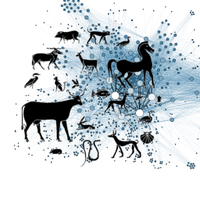Dynamic sensitivity analysis of a mathematical model describing the effect of the macroalgae Asparagopsis taxiformis on rumen fermentation and methane production under in vitro continuous conditions
This article has been Reviewed by the following groups
Discuss this preprint
Start a discussion What are Sciety discussions?Listed in
- Evaluated articles (Peer Community in Animal Science)
Abstract
Ruminants play an important role in global warming by emitting enteric methane (CH 4 ) through the degradation of feeds by the rumen microbiota. To better understand the dynamics fermentation outputs, including CH 4 and volatile fatty acids (VFA) production, mathematical models have been developed. Sensitivity analysis (SA) methods quantify the contribution of model input parameters (IP) to the variation of an output variable of interest. In animal science, SA are usually conducted in static condition. In this work, we hypothesized that including the dynamic aspect of the rumen fermentation to SA can be useful to inform on optimal experimental conditions aimed at quantifying the key mechanisms driving CH 4 and VFA production. Accordingly, the objective of this work was to conduct a dynamic SA of a rumen fermentation model under in vitro continuous conditions (close to the real in vivo conditions). Our model case study integrates the effect of the macroalgae Asparagopsis taxiformis (AT) on the fermentation. AT has been identified as a potent CH 4 inhibitor via the presence of bromoform, an anti-methanogenic compound. We computed Shapley effects over time for quantifying the contribution of 16 IPs to CH 4 (mol/h) and VFA (mol/l) variation. Shapley effects integrate the three contribution types of an IP to output variable variation (individual, via the interactions and via the dependence/correlation). We studied three diet scenarios accounting for several doses of AT relative to Dry Matter (DM): control (0% DM of AT), low treatment (LT: 0.25% DM of AT) and high treatment (HT: 0.50% DM of AT). Shapley effects revealed that hydrogen (H 2 ) utilizers microbial group via its Monod H 2 affinity constant highly contributed (> 50%) to CH 4 variation with a constant dynamic over time for control and LT. A shift on the impact of microbial pathways driving CH 4 variation was revealed for HT. IPs associated with the kinetic of bromoform utilization and with the factor modeling the direct effect of bromoform on methanogenesis were identified as influential on CH 4 variation in the middle of fermentation. Whereas, VFA variation for the three diet scenarios was mainly explained by the kinetic of fibers degradation, showing a high constant contribution (> 30%) over time. The simulations computed for the SA were also used to analyze prediction uncertainty. It was related to the dynamic of dry matter intake (DMI, g/h), increasing during the high intake activity periods and decreasing when the intake activity was low. Moreover, CH 4 (mol/h) simulations showed a larger variability than VFA simulations, suggesting that the reduction of the uncertainty of IPs describing the activity of the H 2 utilizers microbial group is a promising lead to reduce the overall model uncertainty. Our results highlighted the dynamic nature of the influence of metabolic pathways on CH 4 productions under an anti-methanogenic treatment. SA tools can be further exploited to design optimal experiments studying rumen fermentation and CH 4 mitigation strategies. These optimal experiments would be useful to build robust models that can guide the development of sustainable nutrition strategies.


